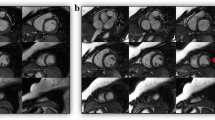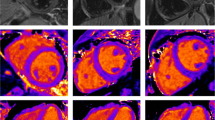Abstract
Purpose
The authors sought to compare magnetic resonance imaging (MRI) and computed tomography (CT) for assessing left ventricular (LV) function parameters in a large patient population.
Materials and methods
The study was conducted on 181 patients who underwent cardiac MRI and cardiac CT for various indications. For MRI, we used two-dimensional cine balanced steady-state free precession (b-SSFP) sequences, and for CT we used multiphase short-axis reconstructions. Volume data sets were evaluated with dedicated software. Results were compared with a paired, two-tailed Student’s t test, Pearson’s correlation (r), and Bland-Altman analysis.
Results
A high level of concordance was observed between cardiac MRI and CT. Ejection fraction (EF) was 53±14% for MRI vs. 53%±15% for CT. There was good correlation for EF (r=0.71; p>0.05) and end-systolic volume (r=0.74; p>0.05). End-diastolic volume (74±23 ml at MRI vs. 71±19 ml at CT; r=0.58; p<0.05) and myocardial mass (63±20 g at MRI and 56±18 g at CT; r=0.89; p<0.01) showed statistically significant differences, although the discrepancy had no clinical impact.
Conclusions
MRI and CT show a good level of agreement in assessing LV function parameters, and both can be used interchangeably in clinical practice.
Riassunto
Obiettivo
Obiettivo di questo lavoro è stato confrontare la risonanza magnetica (RM) e la tomografia computerizzata (TC) per la valutazione dei parametri funzionali del ventricolo sinistro (Vsin) in una vasta popolazione di pazienti.
Materiali e metodi
Sono stati arruolati 181 pazienti che sono stati sottoposti ad esame cardio-RM e cardio-TC. Per la cardio-RM abbiamo utilizzato sequenze 2D cine b-steady-state free-precession (SSFP) e per la TC abbiamo utilizzato delle ricostruzioni multifasiche in asse corto. I data-set di volume sono stati analizzati con un software dedicato: Argus (versione Va60C). I risultati sono stati confrontati con il test t di Student a due code per dati appaiati, la correlazione di Pearson ed l’analisi di Bland-Altman.
Risultati
È stata osservata una elevata concordanza tra la cardio-RM e la cardio-TC. La frazione di eiezione (FE) è stata 53%±14% per la RM e 53%±15% per la TC. Buona correlazione è stata osservata per la FE (r=0,71; p>0,05) e per il volume tele-sistolico (VTS) (r=0,74; p>0,05). Il volume tele-diastolico (74±23 ml per RM e 71±19 ml per TC; r=0,58; p<0,05) e la massa miocardica (63±20 g per RM e 56±18 g per TC; r=0,89; p<0,01) hanno dimostrato differenze statisticamente significative anche se prive di impatto clinico.
Conclusioni
Gli esami cardio-RM e cardio-TC mostrano una eccellente concordanza per la valutazione dei parametri funzionali del Vsin e possono quindi essere utilizzati indifferentemente nella pratica clinica.
Similar content being viewed by others
References/Bibliografia
Moise A, Bourassa MG, Theroux P et al (1985) Prognostic significance of progression of coronary artery disease. Am J Cardiol 55:941–946
Emond M, Mock MB, Davis KB et al (1994) Long-term survival of medically treated patients in the Coronary Artery Surgery Study (CASS) registry. Circulation 90:2645–2657
Juergens KU, Fischbach R (2006) Left ventricular function studied with MDCT. Eur Radiol 16:342–357
de Feyter PJ, van Eenige MJ, Dighton DH et al (1982) Prognostic value of exercise testing, coronary angiography and left ventriculography 6–8 weeks after myocardial infarction. Circulation 66:527–536
Taylor GJ, Humphries JO, Mellits ED et al (1980) Predictors of clinical course, coronary anatomy and left ventricular function after recovery from acute myocardial infarction. Circulation 62:960–970
White HD, Norris RM, Brown MA et al (1987) Left ventricular end-systolic volume as the major determinant of survival after recovery from myocardial infarction. Circulation 76:44–51
Peshock RM, Willett DL, Sayad DE et al (1996) Quantitative MR imaging of the heart. Magn Reson Imaging Clin N Am 4:287–305
Rathi VK, Biedermann RW (2004) Imaging of ventricular function by cardiovascular magnetic resonance. Curr Cardiol Rep 6:55–61
Belge B, Coche E, Pasquet A et al (2006) Accurate estimation of global and regional cardiac function by retrospectively gated multidetector row computed tomography. Comparison with cine magnetic resonance imaging. Eur Radiol 16:1424–1433
Abbara S, Chowa BJW, Pena AJ et al (2008) Assessment of left ventricular function with 16- and 64-slice multidetector computed tomography. Eur J Radiol 67:481–48611.
Bansal D, Singh RM, Sarkar M et al (2008) Assessment of left ventricular unction: comparison of cardiac multidetector-row computed tomography with two-dimension standard echocardiography for assessment of left ventricular function. Int J Cardiovasc Imaging 24:317–325
Heuschmid M, Rothfuss JK, Schroeder S et al (2006) Assessment of left ventricular myocardial function using 16-slice multidetector-row computed tomography: comparison with magnetic resonance imaging and echocardiography. Eur Radiol 16:551–559
Sugeng L, Mor-Avi V, Weinert L et al (2006) Quantitative Assessment of Left Ventricular Size and Function. Side-by-Side Comparison of Real-Time Three-Dimensional Echocardiography and Computed Tomography With Magnetic Resonance Reference. Circulation 114:654–661
Wu YW, Tadamura E, Yamamuro M et al (2008) Estimation of global and regional cardiac function using 64-slice computed tomography: a comparison study with echocardiography, gated-SPECT and cardiovascular magnetic resonance. 128:69–76
Puesken M, Fischbach R, Wenker M et al (2008) Global left-ventricular function assessment using dual-source multidetector CT: effect of improved temporal resolution on ventricular volume measurement. Eur Radiol 18:2087–2094
Krishnam MS, Tomasian A, Ruehm SG et al (2008) Left ventricular ejection fraction using 64-slice CT coronary angiography and new evaluation software: initial experience. Br J Radiol 81:450–455
Busch S, Johnson TRC, Wintersperger J et al (2008) Quantitative assessment of left ventricular function with dual-source CT in comparison to cardiac magnetic resonance imaging: initial findings. Eur Radiol 18:570–575
Brodoefel H, Reimann R, Klumpp B et al (2007) Sixty-four-slice CT in the assessment of global and regional left ventricular function: Comparison with MRI in a porcine model of acute and subacute myocardial infarction. Eur Radiol 17:2948–2956
Levine GN, Gomes AS, Arai AE et al (2007) Safety of magnetic resonance imaging in patients with cardiovascular devices: an American Heart Association scientific statement from the Committee on Diagnostic and Interventional Cardiac Catheterization. Circulation 116:2878–2891
Shellock FG, Spinazzi A (2008) MRI Safety Update: 2008, Part 2, Screening patients for MRI. AJR Am J Roentgenol 191:12–21
Cademartiri F, Romano M, Seitun S et al (2008) Prevalence and characteristics of coronary artery disease in a population with suspected ischaemic heart disease using CT coronary angiography: correlations with cardiovascular risk factors and clinical presentation. Radiol Med 113:363–372
Schroeder S, Kopp AF, Kuettner A et al (2002) Influence of heart rate on vessel visibility in noninvasive coronary angiography using new multislice computed tomography. Experience in 94 patients. J Clin Imaging 26:106–111
Partridge JB, Anderson RH (2009) Left ventricular anatomy: its nomenclature, segmentation, and planes of imaging. Clinical Anatomy 22:77–84
Hergan K, Schuster A, Frühwald J et al (2008) Comparison of left and right ventricular volume measurement using the Simpson’s method and the area length method. Eur J Radiol 65:270–278
Lorenz CH, Walker ES, Morgan VL et al (1999) Normal human right and left ventricular mass, systolic function, and gender differences by cine magnetic resonance imaging. J Cardiovasc Magn Reson 1:7–21
Miller S, Simonetti OP, Carr J et al (2002) MR imaging of the heart with cine true fast imaging with steady-state precession: influence of spatial and temporal resolutions on left ventricular functional parameters. Radiology 223:263–269
van Geuns RJ, Baks T, Gronenschild EH et al (2006) Automatic quantitative left ventricular analysis of cine MR images by using three-dimensional information for contour detection. Radiology 240:215–221
Sievers B, Kirchberg S, Bakan A et al (2004) Impact of papillary muscles in ventricular volume and ejection fraction assessment by cardiovascular magnetic resonance. J Cardiovasc Magn Reson 6:9–16
Hendel RC, Patel MR, Kramer CM et al (2006) ACCF/ACR/SCCT/SCMR/ASNC/NASCI/SCAI/SIR appropriateness criteria for cardiac computed tomography and cardiac magnetic resonance imaging: a report of the American College of Cardiology Foundation Quality Strategic Directions Committee Appropriateness Criteria Working Group, American College of Radiology, Society of Cardiovascular Computed Tomography, Society for Cardiovascular Magnetic Resonance, American Society of Nuclear Cardiology, North American Society for Cardiac Imaging, Society for Cardiovascular Angiography and Interventions, and Society of Interventional Radiology. J Am Coll Cardiol 48:1475–1497
Author information
Authors and Affiliations
Corresponding author
Rights and permissions
About this article
Cite this article
Palumbo, A., Maffei, E., Martini, C. et al. Functional parameters of the left ventricle: comparison of cardiac MRI and cardiac CT in a large population. Radiol med 115, 702–713 (2010). https://doi.org/10.1007/s11547-010-0525-0
Received:
Accepted:
Published:
Issue Date:
DOI: https://doi.org/10.1007/s11547-010-0525-0
Keywords
- Cardiac magnetic resonance
- Cardiac computed tomography
- Left ventricular volumes
- Quantitative software
- Ejection fraction




